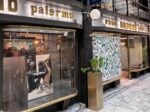You Are What You Are
 (480x337).jpg)
Sarà possibile in un lontano futuro capire il nostro stato attuale sulla base degli oggetti che si saranno conservati nel tempo, così come noi cerchiamo di fare con la preistoria dell’umanità sulla base dei reperti archeologici e geologici? Cos’è ciò che ci rende quello che siamo e in cosa differiamo dalla natura? Alla fine, resta l’interrogativo di che cosa sarà di noi – e della natura.
Comunicato stampa
La Galleria Mario Iannelli è lieta di presentare “You Are What You Are” una mostra collettiva di nove giovani artisti emergenti, le cui opere affrontano il tema della natura come materiale della nostra esistenza, servendosi di molteplici approcci artistici ed esaminando le complesse interazioni reciproche tra natura e uomini. In questo contesto, ad esempio, il tema delle trasformazioni ambientali irreversibili causate dall’azione dall’uomo svolge un ruolo altrettanto importante quanto la rappresentazione della storia, delle origini e delle esperienze soggettive, esposta attraverso materiali naturali. Nella mostra vengono resi visibili processi naturali, quali crescita, sovrapposizione e stratificazione così come tracce di luce; facendoci riflettere sul nostro passato, sulla nostra civilizzazione e sul nostro futuro, chiedendosi come il mondo di domani comprenderà quello di oggi. Sarà possibile in un lontano futuro capire il nostro stato attuale sulla base degli oggetti che si saranno conservati nel tempo, così come noi cerchiamo di fare con la preistoria dell’umanità sulla base dei reperti archeologici e geologici? Cos’è ciò che ci rende quello che siamo e in cosa differiamo dalla natura? Alla fine, resta l’interrogativo di che cosa sarà di noi – e della natura.
Galleria Mario Iannelli is pleased to announce the opening of "You Are What You Are“, a group exhibition that presents nine emerging artists who deal with nature as the material of our existence. The artistic approaches are diverse and examine the correlations of nature and human beings in various complex ways. The aspect of irreversible alterations caused by humans on our environment matters equally as the visualisation of history, origin and subjective experiences, displayed trough natural materials. Natural processes such as growth, overlay and layering are being visualised in the exhibition as well as traces of light; Questions on our civilizational and historical past are being asked as well as how our future could be looking like and how our posterity will understand our momentary present. Will it be possible to reconstruct our current state on the basis of leftover objects, similar to our usual practice to examine the earliest history of mankinds trough objects and geology? What is it that makes us the way we are and the way we act, and what separates us from nature? At the end, there will be the question of what is going to remain of us – and what will remain of nature.



